Tajikistan's Economic Development Challenges
VerifiedAdded on 2020/05/28
|13
|3877
|70
AI Summary
This assignment analyzes various aspects of Tajikistan's economy. It delves into issues related to trade facilitation, highlighting the country's efforts to improve its export competitiveness. The analysis also covers energy efficiency, agricultural practices, and the challenges posed by water resource scarcity in the Zarafshan River basin. Additionally, the document sheds light on Tajikistan's relations with India and Uzbekistan, examining potential conflicts and areas of cooperation.
Contribute Materials
Your contribution can guide someone’s learning journey. Share your
documents today.
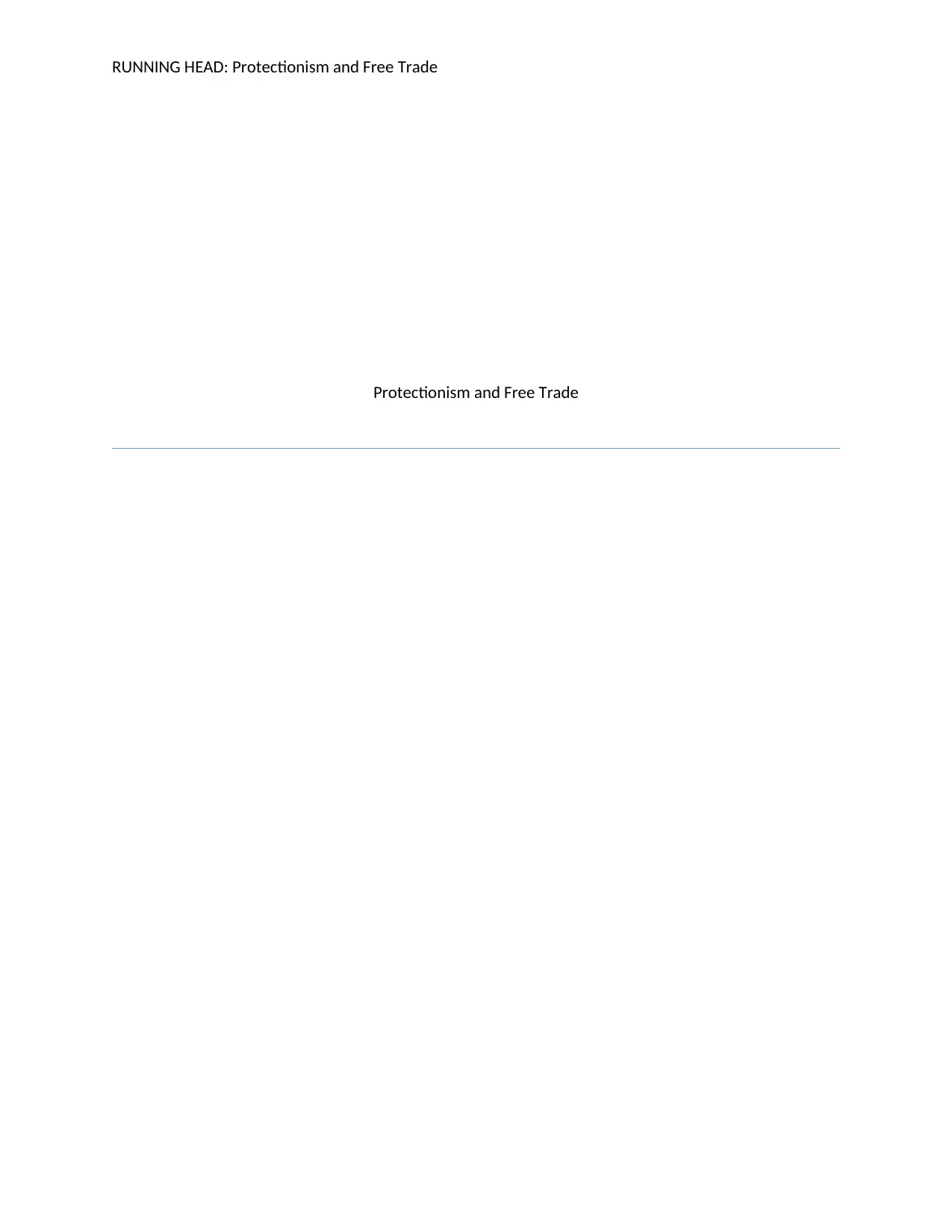
RUNNING HEAD: Protectionism and Free Trade
Protectionism and Free Trade
Protectionism and Free Trade
Secure Best Marks with AI Grader
Need help grading? Try our AI Grader for instant feedback on your assignments.
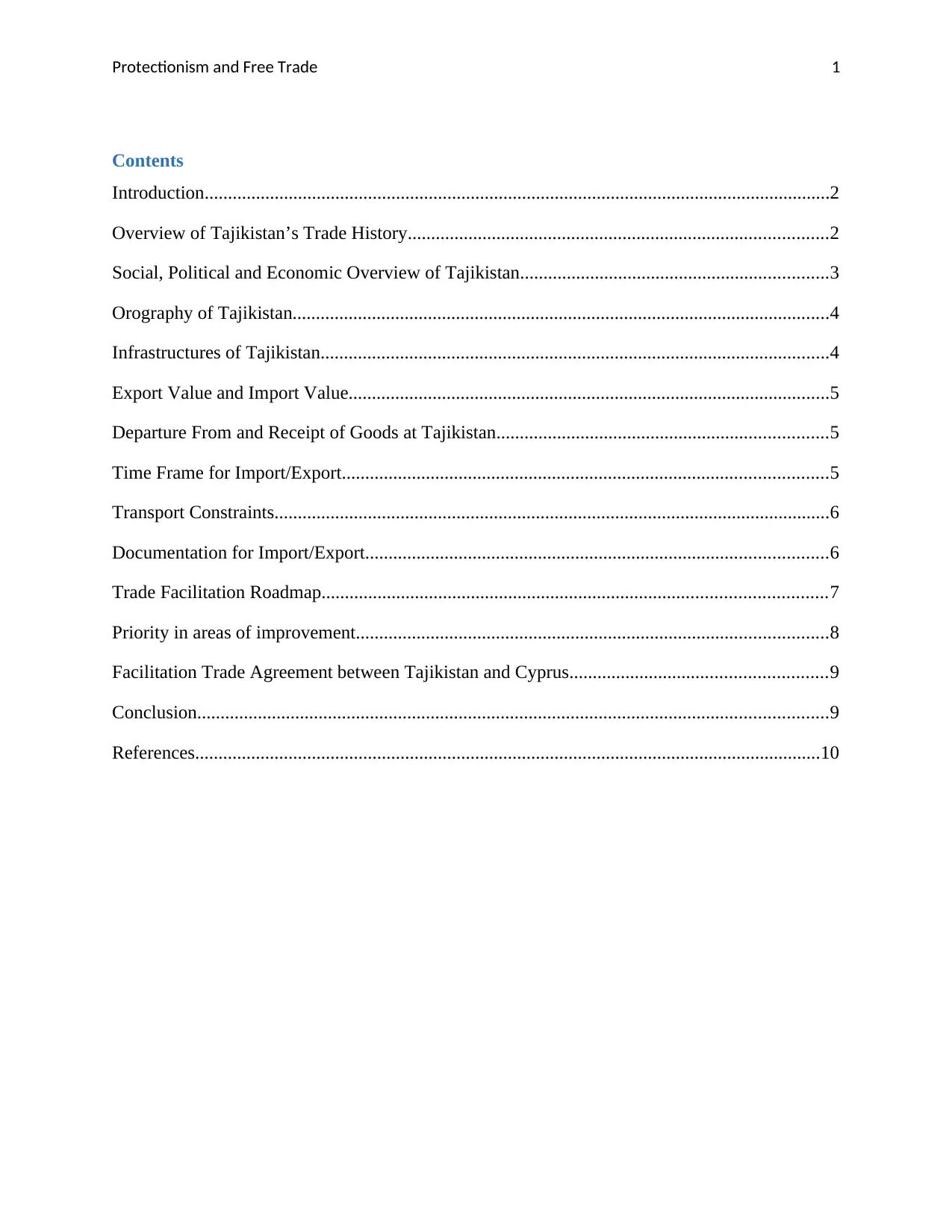
Protectionism and Free Trade 1
Contents
Introduction......................................................................................................................................2
Overview of Tajikistan’s Trade History..........................................................................................2
Social, Political and Economic Overview of Tajikistan..................................................................3
Orography of Tajikistan...................................................................................................................4
Infrastructures of Tajikistan.............................................................................................................4
Export Value and Import Value.......................................................................................................5
Departure From and Receipt of Goods at Tajikistan.......................................................................5
Time Frame for Import/Export........................................................................................................5
Transport Constraints.......................................................................................................................6
Documentation for Import/Export...................................................................................................6
Trade Facilitation Roadmap............................................................................................................7
Priority in areas of improvement.....................................................................................................8
Facilitation Trade Agreement between Tajikistan and Cyprus.......................................................9
Conclusion.......................................................................................................................................9
References......................................................................................................................................10
Contents
Introduction......................................................................................................................................2
Overview of Tajikistan’s Trade History..........................................................................................2
Social, Political and Economic Overview of Tajikistan..................................................................3
Orography of Tajikistan...................................................................................................................4
Infrastructures of Tajikistan.............................................................................................................4
Export Value and Import Value.......................................................................................................5
Departure From and Receipt of Goods at Tajikistan.......................................................................5
Time Frame for Import/Export........................................................................................................5
Transport Constraints.......................................................................................................................6
Documentation for Import/Export...................................................................................................6
Trade Facilitation Roadmap............................................................................................................7
Priority in areas of improvement.....................................................................................................8
Facilitation Trade Agreement between Tajikistan and Cyprus.......................................................9
Conclusion.......................................................................................................................................9
References......................................................................................................................................10
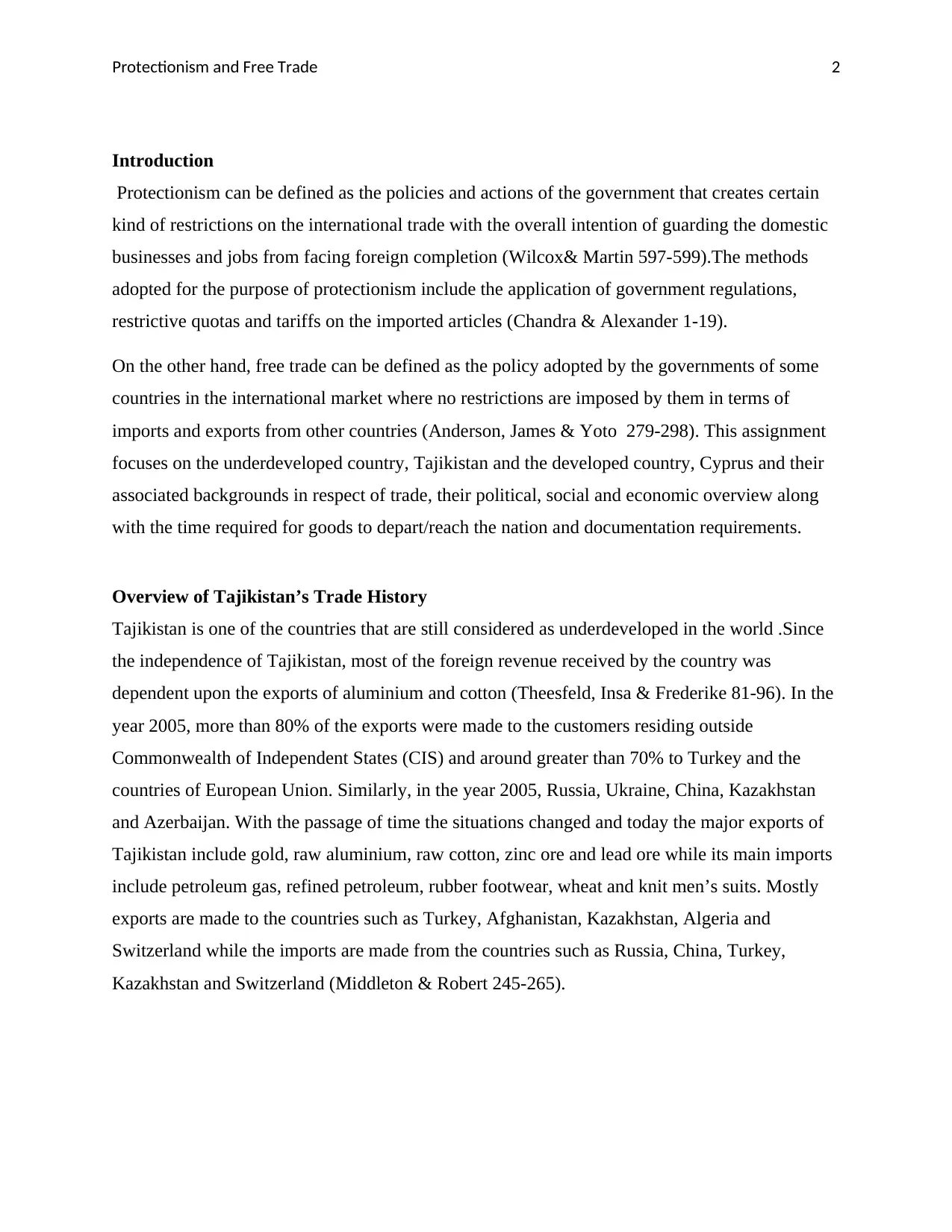
Protectionism and Free Trade 2
Introduction
Protectionism can be defined as the policies and actions of the government that creates certain
kind of restrictions on the international trade with the overall intention of guarding the domestic
businesses and jobs from facing foreign completion (Wilcox& Martin 597-599).The methods
adopted for the purpose of protectionism include the application of government regulations,
restrictive quotas and tariffs on the imported articles (Chandra & Alexander 1-19).
On the other hand, free trade can be defined as the policy adopted by the governments of some
countries in the international market where no restrictions are imposed by them in terms of
imports and exports from other countries (Anderson, James & Yoto 279-298). This assignment
focuses on the underdeveloped country, Tajikistan and the developed country, Cyprus and their
associated backgrounds in respect of trade, their political, social and economic overview along
with the time required for goods to depart/reach the nation and documentation requirements.
Overview of Tajikistan’s Trade History
Tajikistan is one of the countries that are still considered as underdeveloped in the world .Since
the independence of Tajikistan, most of the foreign revenue received by the country was
dependent upon the exports of aluminium and cotton (Theesfeld, Insa & Frederike 81-96). In the
year 2005, more than 80% of the exports were made to the customers residing outside
Commonwealth of Independent States (CIS) and around greater than 70% to Turkey and the
countries of European Union. Similarly, in the year 2005, Russia, Ukraine, China, Kazakhstan
and Azerbaijan. With the passage of time the situations changed and today the major exports of
Tajikistan include gold, raw aluminium, raw cotton, zinc ore and lead ore while its main imports
include petroleum gas, refined petroleum, rubber footwear, wheat and knit men’s suits. Mostly
exports are made to the countries such as Turkey, Afghanistan, Kazakhstan, Algeria and
Switzerland while the imports are made from the countries such as Russia, China, Turkey,
Kazakhstan and Switzerland (Middleton & Robert 245-265).
Introduction
Protectionism can be defined as the policies and actions of the government that creates certain
kind of restrictions on the international trade with the overall intention of guarding the domestic
businesses and jobs from facing foreign completion (Wilcox& Martin 597-599).The methods
adopted for the purpose of protectionism include the application of government regulations,
restrictive quotas and tariffs on the imported articles (Chandra & Alexander 1-19).
On the other hand, free trade can be defined as the policy adopted by the governments of some
countries in the international market where no restrictions are imposed by them in terms of
imports and exports from other countries (Anderson, James & Yoto 279-298). This assignment
focuses on the underdeveloped country, Tajikistan and the developed country, Cyprus and their
associated backgrounds in respect of trade, their political, social and economic overview along
with the time required for goods to depart/reach the nation and documentation requirements.
Overview of Tajikistan’s Trade History
Tajikistan is one of the countries that are still considered as underdeveloped in the world .Since
the independence of Tajikistan, most of the foreign revenue received by the country was
dependent upon the exports of aluminium and cotton (Theesfeld, Insa & Frederike 81-96). In the
year 2005, more than 80% of the exports were made to the customers residing outside
Commonwealth of Independent States (CIS) and around greater than 70% to Turkey and the
countries of European Union. Similarly, in the year 2005, Russia, Ukraine, China, Kazakhstan
and Azerbaijan. With the passage of time the situations changed and today the major exports of
Tajikistan include gold, raw aluminium, raw cotton, zinc ore and lead ore while its main imports
include petroleum gas, refined petroleum, rubber footwear, wheat and knit men’s suits. Mostly
exports are made to the countries such as Turkey, Afghanistan, Kazakhstan, Algeria and
Switzerland while the imports are made from the countries such as Russia, China, Turkey,
Kazakhstan and Switzerland (Middleton & Robert 245-265).
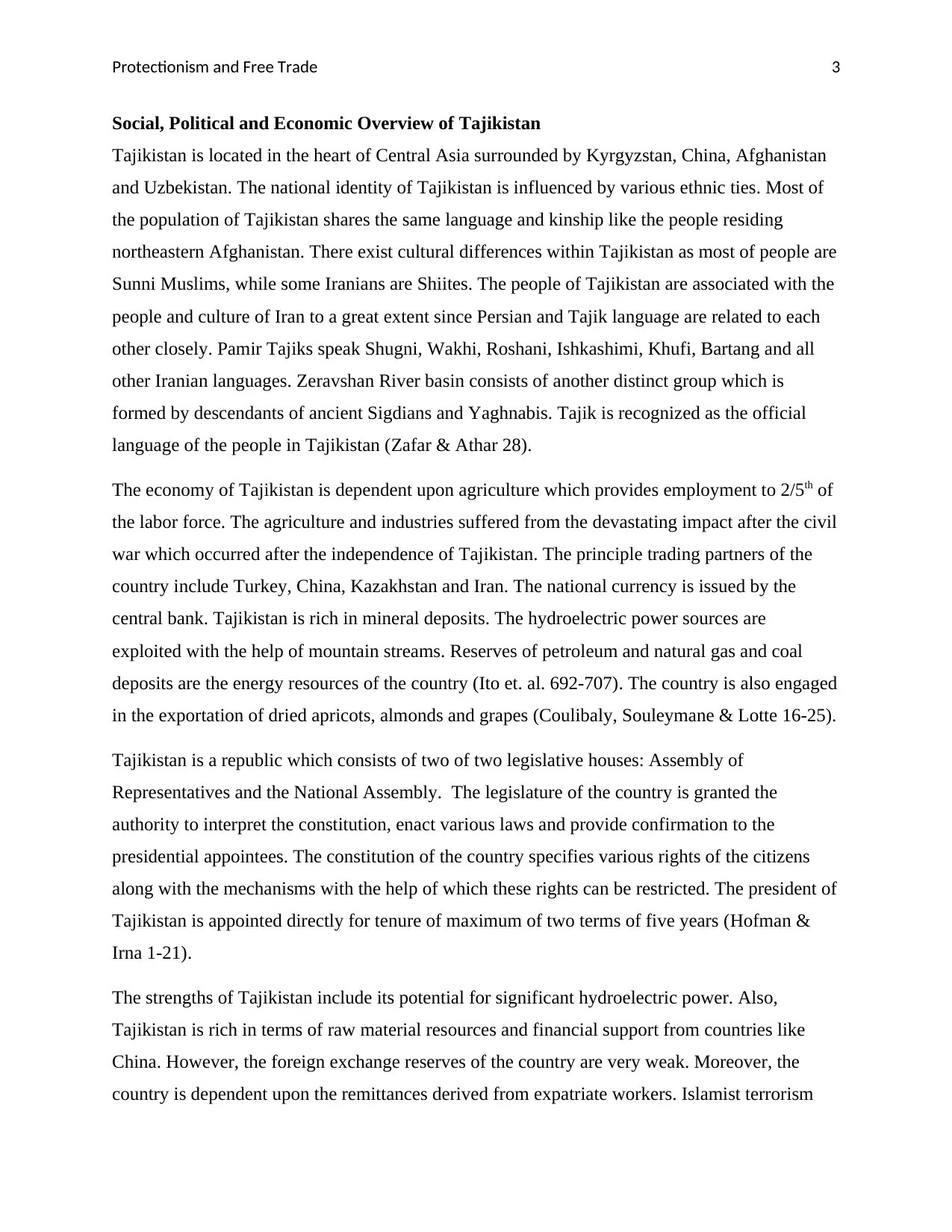
Protectionism and Free Trade 3
Social, Political and Economic Overview of Tajikistan
Tajikistan is located in the heart of Central Asia surrounded by Kyrgyzstan, China, Afghanistan
and Uzbekistan. The national identity of Tajikistan is influenced by various ethnic ties. Most of
the population of Tajikistan shares the same language and kinship like the people residing
northeastern Afghanistan. There exist cultural differences within Tajikistan as most of people are
Sunni Muslims, while some Iranians are Shiites. The people of Tajikistan are associated with the
people and culture of Iran to a great extent since Persian and Tajik language are related to each
other closely. Pamir Tajiks speak Shugni, Wakhi, Roshani, Ishkashimi, Khufi, Bartang and all
other Iranian languages. Zeravshan River basin consists of another distinct group which is
formed by descendants of ancient Sigdians and Yaghnabis. Tajik is recognized as the official
language of the people in Tajikistan (Zafar & Athar 28).
The economy of Tajikistan is dependent upon agriculture which provides employment to 2/5th of
the labor force. The agriculture and industries suffered from the devastating impact after the civil
war which occurred after the independence of Tajikistan. The principle trading partners of the
country include Turkey, China, Kazakhstan and Iran. The national currency is issued by the
central bank. Tajikistan is rich in mineral deposits. The hydroelectric power sources are
exploited with the help of mountain streams. Reserves of petroleum and natural gas and coal
deposits are the energy resources of the country (Ito et. al. 692-707). The country is also engaged
in the exportation of dried apricots, almonds and grapes (Coulibaly, Souleymane & Lotte 16-25).
Tajikistan is a republic which consists of two of two legislative houses: Assembly of
Representatives and the National Assembly. The legislature of the country is granted the
authority to interpret the constitution, enact various laws and provide confirmation to the
presidential appointees. The constitution of the country specifies various rights of the citizens
along with the mechanisms with the help of which these rights can be restricted. The president of
Tajikistan is appointed directly for tenure of maximum of two terms of five years (Hofman &
Irna 1-21).
The strengths of Tajikistan include its potential for significant hydroelectric power. Also,
Tajikistan is rich in terms of raw material resources and financial support from countries like
China. However, the foreign exchange reserves of the country are very weak. Moreover, the
country is dependent upon the remittances derived from expatriate workers. Islamist terrorism
Social, Political and Economic Overview of Tajikistan
Tajikistan is located in the heart of Central Asia surrounded by Kyrgyzstan, China, Afghanistan
and Uzbekistan. The national identity of Tajikistan is influenced by various ethnic ties. Most of
the population of Tajikistan shares the same language and kinship like the people residing
northeastern Afghanistan. There exist cultural differences within Tajikistan as most of people are
Sunni Muslims, while some Iranians are Shiites. The people of Tajikistan are associated with the
people and culture of Iran to a great extent since Persian and Tajik language are related to each
other closely. Pamir Tajiks speak Shugni, Wakhi, Roshani, Ishkashimi, Khufi, Bartang and all
other Iranian languages. Zeravshan River basin consists of another distinct group which is
formed by descendants of ancient Sigdians and Yaghnabis. Tajik is recognized as the official
language of the people in Tajikistan (Zafar & Athar 28).
The economy of Tajikistan is dependent upon agriculture which provides employment to 2/5th of
the labor force. The agriculture and industries suffered from the devastating impact after the civil
war which occurred after the independence of Tajikistan. The principle trading partners of the
country include Turkey, China, Kazakhstan and Iran. The national currency is issued by the
central bank. Tajikistan is rich in mineral deposits. The hydroelectric power sources are
exploited with the help of mountain streams. Reserves of petroleum and natural gas and coal
deposits are the energy resources of the country (Ito et. al. 692-707). The country is also engaged
in the exportation of dried apricots, almonds and grapes (Coulibaly, Souleymane & Lotte 16-25).
Tajikistan is a republic which consists of two of two legislative houses: Assembly of
Representatives and the National Assembly. The legislature of the country is granted the
authority to interpret the constitution, enact various laws and provide confirmation to the
presidential appointees. The constitution of the country specifies various rights of the citizens
along with the mechanisms with the help of which these rights can be restricted. The president of
Tajikistan is appointed directly for tenure of maximum of two terms of five years (Hofman &
Irna 1-21).
The strengths of Tajikistan include its potential for significant hydroelectric power. Also,
Tajikistan is rich in terms of raw material resources and financial support from countries like
China. However, the foreign exchange reserves of the country are very weak. Moreover, the
country is dependent upon the remittances derived from expatriate workers. Islamist terrorism
Secure Best Marks with AI Grader
Need help grading? Try our AI Grader for instant feedback on your assignments.
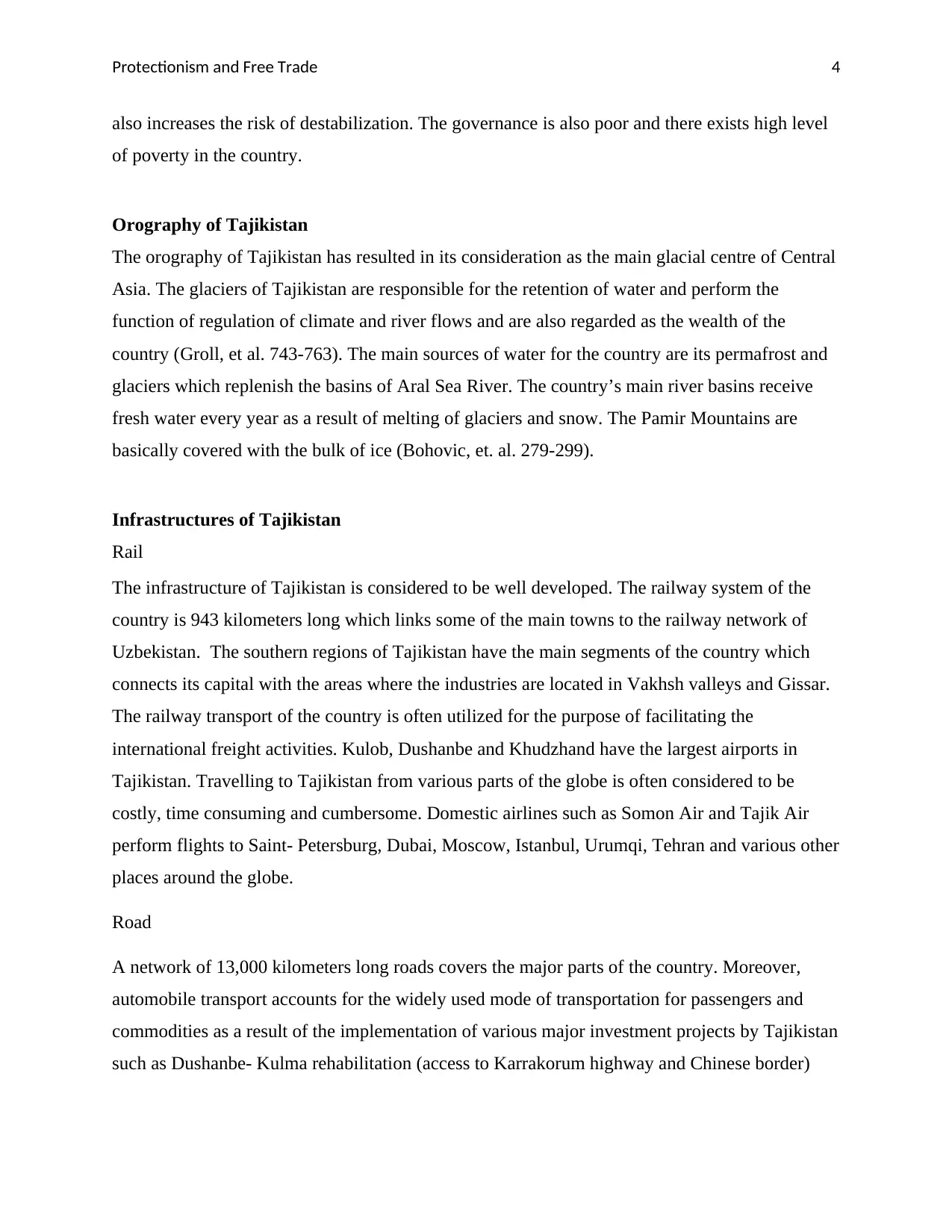
Protectionism and Free Trade 4
also increases the risk of destabilization. The governance is also poor and there exists high level
of poverty in the country.
Orography of Tajikistan
The orography of Tajikistan has resulted in its consideration as the main glacial centre of Central
Asia. The glaciers of Tajikistan are responsible for the retention of water and perform the
function of regulation of climate and river flows and are also regarded as the wealth of the
country (Groll, et al. 743-763). The main sources of water for the country are its permafrost and
glaciers which replenish the basins of Aral Sea River. The country’s main river basins receive
fresh water every year as a result of melting of glaciers and snow. The Pamir Mountains are
basically covered with the bulk of ice (Bohovic, et. al. 279-299).
Infrastructures of Tajikistan
Rail
The infrastructure of Tajikistan is considered to be well developed. The railway system of the
country is 943 kilometers long which links some of the main towns to the railway network of
Uzbekistan. The southern regions of Tajikistan have the main segments of the country which
connects its capital with the areas where the industries are located in Vakhsh valleys and Gissar.
The railway transport of the country is often utilized for the purpose of facilitating the
international freight activities. Kulob, Dushanbe and Khudzhand have the largest airports in
Tajikistan. Travelling to Tajikistan from various parts of the globe is often considered to be
costly, time consuming and cumbersome. Domestic airlines such as Somon Air and Tajik Air
perform flights to Saint- Petersburg, Dubai, Moscow, Istanbul, Urumqi, Tehran and various other
places around the globe.
Road
A network of 13,000 kilometers long roads covers the major parts of the country. Moreover,
automobile transport accounts for the widely used mode of transportation for passengers and
commodities as a result of the implementation of various major investment projects by Tajikistan
such as Dushanbe- Kulma rehabilitation (access to Karrakorum highway and Chinese border)
also increases the risk of destabilization. The governance is also poor and there exists high level
of poverty in the country.
Orography of Tajikistan
The orography of Tajikistan has resulted in its consideration as the main glacial centre of Central
Asia. The glaciers of Tajikistan are responsible for the retention of water and perform the
function of regulation of climate and river flows and are also regarded as the wealth of the
country (Groll, et al. 743-763). The main sources of water for the country are its permafrost and
glaciers which replenish the basins of Aral Sea River. The country’s main river basins receive
fresh water every year as a result of melting of glaciers and snow. The Pamir Mountains are
basically covered with the bulk of ice (Bohovic, et. al. 279-299).
Infrastructures of Tajikistan
Rail
The infrastructure of Tajikistan is considered to be well developed. The railway system of the
country is 943 kilometers long which links some of the main towns to the railway network of
Uzbekistan. The southern regions of Tajikistan have the main segments of the country which
connects its capital with the areas where the industries are located in Vakhsh valleys and Gissar.
The railway transport of the country is often utilized for the purpose of facilitating the
international freight activities. Kulob, Dushanbe and Khudzhand have the largest airports in
Tajikistan. Travelling to Tajikistan from various parts of the globe is often considered to be
costly, time consuming and cumbersome. Domestic airlines such as Somon Air and Tajik Air
perform flights to Saint- Petersburg, Dubai, Moscow, Istanbul, Urumqi, Tehran and various other
places around the globe.
Road
A network of 13,000 kilometers long roads covers the major parts of the country. Moreover,
automobile transport accounts for the widely used mode of transportation for passengers and
commodities as a result of the implementation of various major investment projects by Tajikistan
such as Dushanbe- Kulma rehabilitation (access to Karrakorum highway and Chinese border)
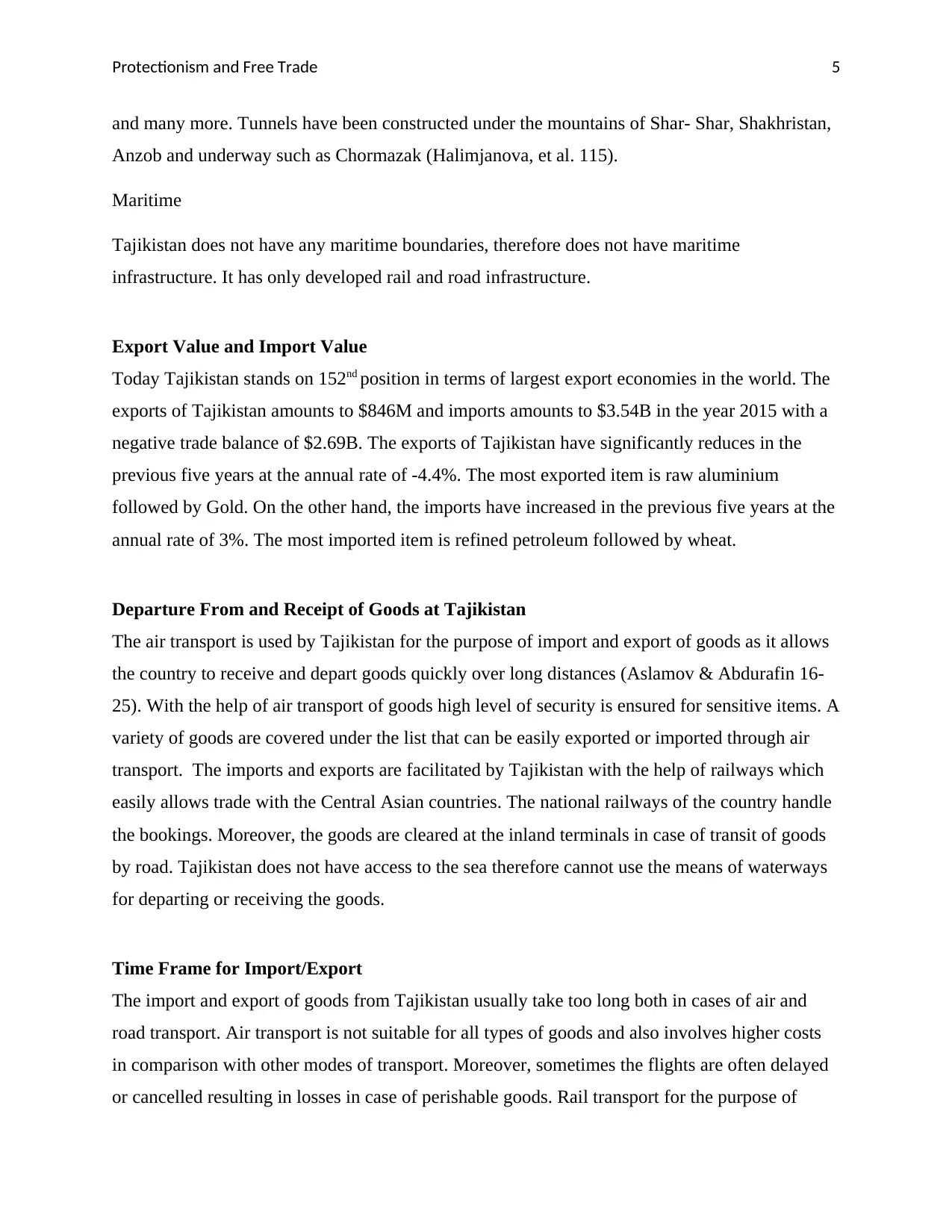
Protectionism and Free Trade 5
and many more. Tunnels have been constructed under the mountains of Shar- Shar, Shakhristan,
Anzob and underway such as Chormazak (Halimjanova, et al. 115).
Maritime
Tajikistan does not have any maritime boundaries, therefore does not have maritime
infrastructure. It has only developed rail and road infrastructure.
Export Value and Import Value
Today Tajikistan stands on 152nd position in terms of largest export economies in the world. The
exports of Tajikistan amounts to $846M and imports amounts to $3.54B in the year 2015 with a
negative trade balance of $2.69B. The exports of Tajikistan have significantly reduces in the
previous five years at the annual rate of -4.4%. The most exported item is raw aluminium
followed by Gold. On the other hand, the imports have increased in the previous five years at the
annual rate of 3%. The most imported item is refined petroleum followed by wheat.
Departure From and Receipt of Goods at Tajikistan
The air transport is used by Tajikistan for the purpose of import and export of goods as it allows
the country to receive and depart goods quickly over long distances (Aslamov & Abdurafin 16-
25). With the help of air transport of goods high level of security is ensured for sensitive items. A
variety of goods are covered under the list that can be easily exported or imported through air
transport. The imports and exports are facilitated by Tajikistan with the help of railways which
easily allows trade with the Central Asian countries. The national railways of the country handle
the bookings. Moreover, the goods are cleared at the inland terminals in case of transit of goods
by road. Tajikistan does not have access to the sea therefore cannot use the means of waterways
for departing or receiving the goods.
Time Frame for Import/Export
The import and export of goods from Tajikistan usually take too long both in cases of air and
road transport. Air transport is not suitable for all types of goods and also involves higher costs
in comparison with other modes of transport. Moreover, sometimes the flights are often delayed
or cancelled resulting in losses in case of perishable goods. Rail transport for the purpose of
and many more. Tunnels have been constructed under the mountains of Shar- Shar, Shakhristan,
Anzob and underway such as Chormazak (Halimjanova, et al. 115).
Maritime
Tajikistan does not have any maritime boundaries, therefore does not have maritime
infrastructure. It has only developed rail and road infrastructure.
Export Value and Import Value
Today Tajikistan stands on 152nd position in terms of largest export economies in the world. The
exports of Tajikistan amounts to $846M and imports amounts to $3.54B in the year 2015 with a
negative trade balance of $2.69B. The exports of Tajikistan have significantly reduces in the
previous five years at the annual rate of -4.4%. The most exported item is raw aluminium
followed by Gold. On the other hand, the imports have increased in the previous five years at the
annual rate of 3%. The most imported item is refined petroleum followed by wheat.
Departure From and Receipt of Goods at Tajikistan
The air transport is used by Tajikistan for the purpose of import and export of goods as it allows
the country to receive and depart goods quickly over long distances (Aslamov & Abdurafin 16-
25). With the help of air transport of goods high level of security is ensured for sensitive items. A
variety of goods are covered under the list that can be easily exported or imported through air
transport. The imports and exports are facilitated by Tajikistan with the help of railways which
easily allows trade with the Central Asian countries. The national railways of the country handle
the bookings. Moreover, the goods are cleared at the inland terminals in case of transit of goods
by road. Tajikistan does not have access to the sea therefore cannot use the means of waterways
for departing or receiving the goods.
Time Frame for Import/Export
The import and export of goods from Tajikistan usually take too long both in cases of air and
road transport. Air transport is not suitable for all types of goods and also involves higher costs
in comparison with other modes of transport. Moreover, sometimes the flights are often delayed
or cancelled resulting in losses in case of perishable goods. Rail transport for the purpose of
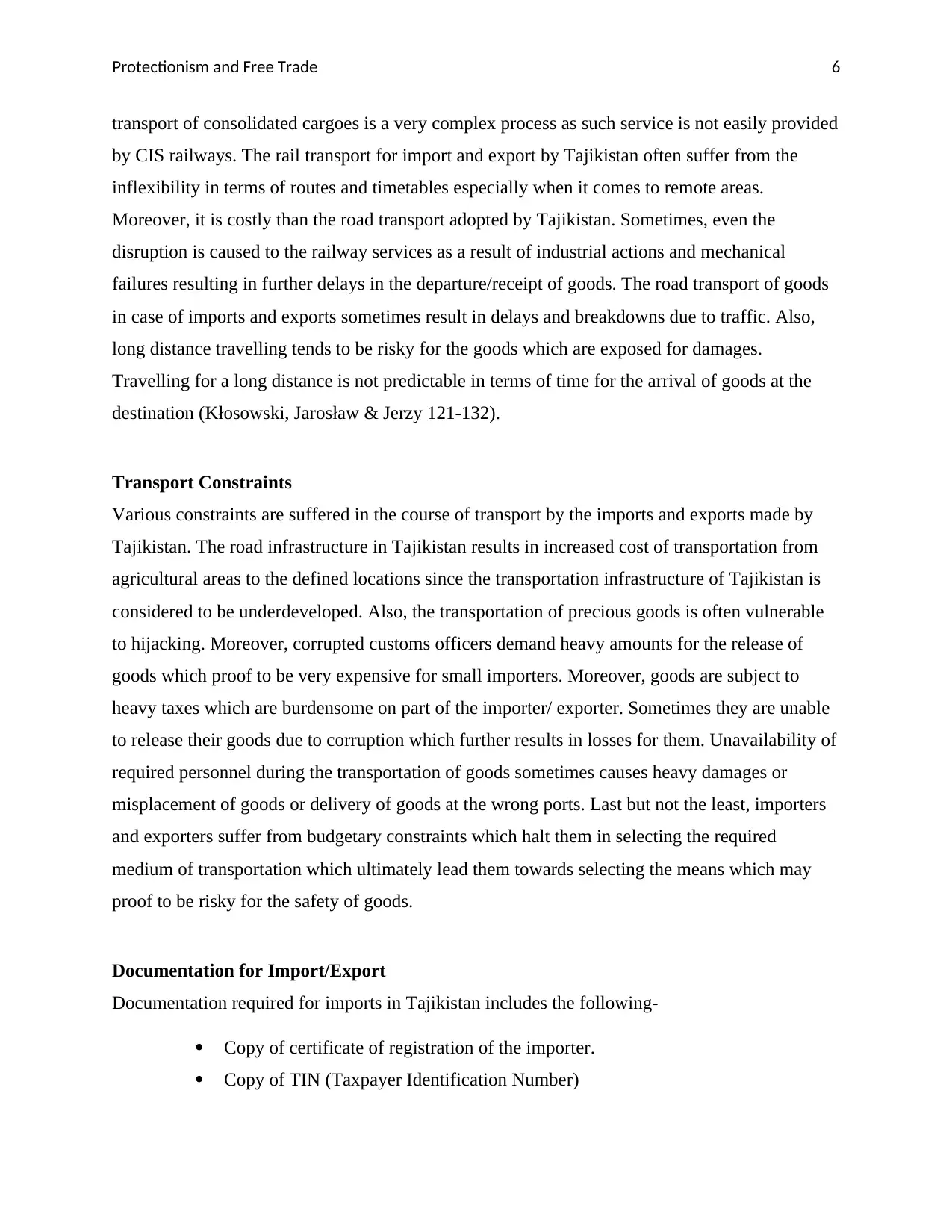
Protectionism and Free Trade 6
transport of consolidated cargoes is a very complex process as such service is not easily provided
by CIS railways. The rail transport for import and export by Tajikistan often suffer from the
inflexibility in terms of routes and timetables especially when it comes to remote areas.
Moreover, it is costly than the road transport adopted by Tajikistan. Sometimes, even the
disruption is caused to the railway services as a result of industrial actions and mechanical
failures resulting in further delays in the departure/receipt of goods. The road transport of goods
in case of imports and exports sometimes result in delays and breakdowns due to traffic. Also,
long distance travelling tends to be risky for the goods which are exposed for damages.
Travelling for a long distance is not predictable in terms of time for the arrival of goods at the
destination (Kłosowski, Jarosław & Jerzy 121-132).
Transport Constraints
Various constraints are suffered in the course of transport by the imports and exports made by
Tajikistan. The road infrastructure in Tajikistan results in increased cost of transportation from
agricultural areas to the defined locations since the transportation infrastructure of Tajikistan is
considered to be underdeveloped. Also, the transportation of precious goods is often vulnerable
to hijacking. Moreover, corrupted customs officers demand heavy amounts for the release of
goods which proof to be very expensive for small importers. Moreover, goods are subject to
heavy taxes which are burdensome on part of the importer/ exporter. Sometimes they are unable
to release their goods due to corruption which further results in losses for them. Unavailability of
required personnel during the transportation of goods sometimes causes heavy damages or
misplacement of goods or delivery of goods at the wrong ports. Last but not the least, importers
and exporters suffer from budgetary constraints which halt them in selecting the required
medium of transportation which ultimately lead them towards selecting the means which may
proof to be risky for the safety of goods.
Documentation for Import/Export
Documentation required for imports in Tajikistan includes the following-
Copy of certificate of registration of the importer.
Copy of TIN (Taxpayer Identification Number)
transport of consolidated cargoes is a very complex process as such service is not easily provided
by CIS railways. The rail transport for import and export by Tajikistan often suffer from the
inflexibility in terms of routes and timetables especially when it comes to remote areas.
Moreover, it is costly than the road transport adopted by Tajikistan. Sometimes, even the
disruption is caused to the railway services as a result of industrial actions and mechanical
failures resulting in further delays in the departure/receipt of goods. The road transport of goods
in case of imports and exports sometimes result in delays and breakdowns due to traffic. Also,
long distance travelling tends to be risky for the goods which are exposed for damages.
Travelling for a long distance is not predictable in terms of time for the arrival of goods at the
destination (Kłosowski, Jarosław & Jerzy 121-132).
Transport Constraints
Various constraints are suffered in the course of transport by the imports and exports made by
Tajikistan. The road infrastructure in Tajikistan results in increased cost of transportation from
agricultural areas to the defined locations since the transportation infrastructure of Tajikistan is
considered to be underdeveloped. Also, the transportation of precious goods is often vulnerable
to hijacking. Moreover, corrupted customs officers demand heavy amounts for the release of
goods which proof to be very expensive for small importers. Moreover, goods are subject to
heavy taxes which are burdensome on part of the importer/ exporter. Sometimes they are unable
to release their goods due to corruption which further results in losses for them. Unavailability of
required personnel during the transportation of goods sometimes causes heavy damages or
misplacement of goods or delivery of goods at the wrong ports. Last but not the least, importers
and exporters suffer from budgetary constraints which halt them in selecting the required
medium of transportation which ultimately lead them towards selecting the means which may
proof to be risky for the safety of goods.
Documentation for Import/Export
Documentation required for imports in Tajikistan includes the following-
Copy of certificate of registration of the importer.
Copy of TIN (Taxpayer Identification Number)
Paraphrase This Document
Need a fresh take? Get an instant paraphrase of this document with our AI Paraphraser
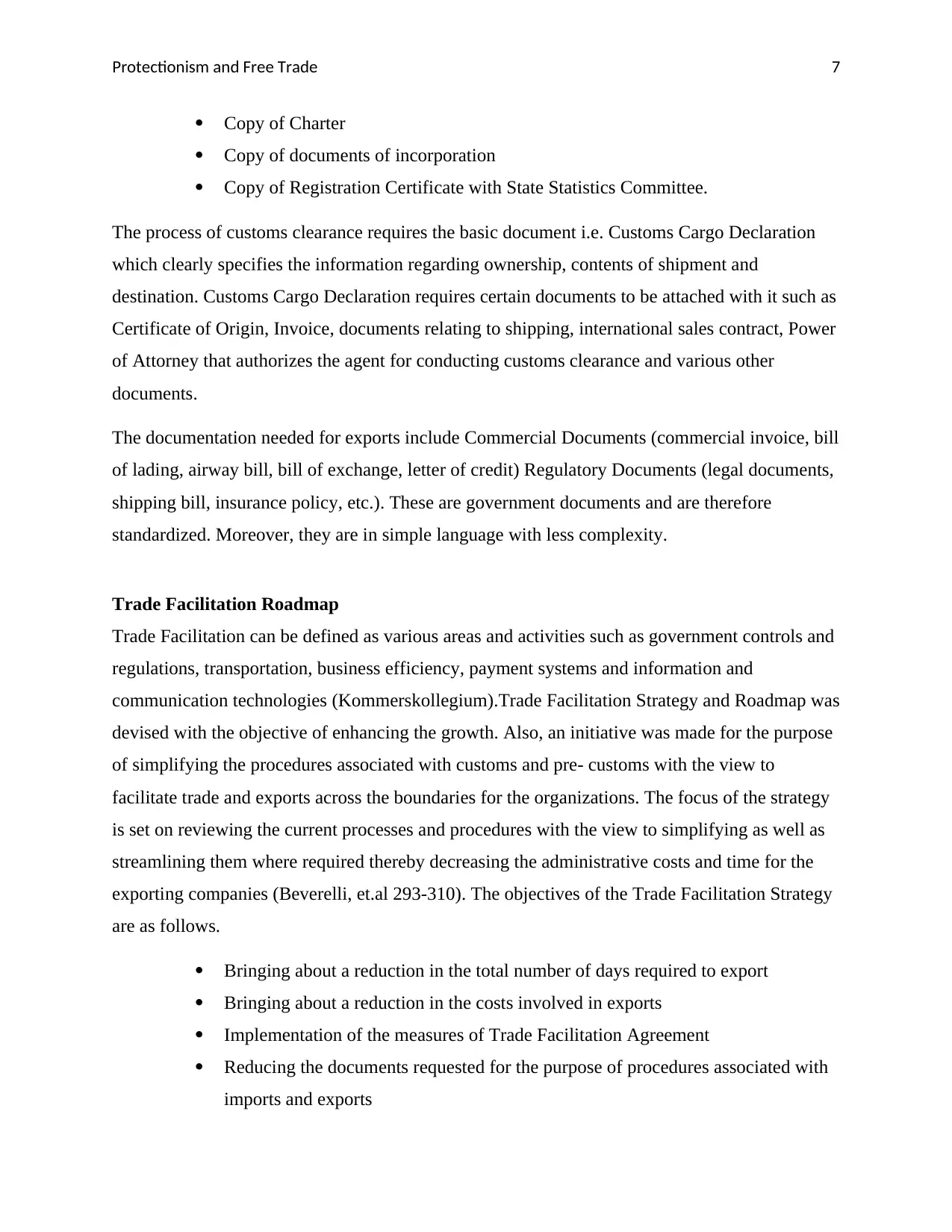
Protectionism and Free Trade 7
Copy of Charter
Copy of documents of incorporation
Copy of Registration Certificate with State Statistics Committee.
The process of customs clearance requires the basic document i.e. Customs Cargo Declaration
which clearly specifies the information regarding ownership, contents of shipment and
destination. Customs Cargo Declaration requires certain documents to be attached with it such as
Certificate of Origin, Invoice, documents relating to shipping, international sales contract, Power
of Attorney that authorizes the agent for conducting customs clearance and various other
documents.
The documentation needed for exports include Commercial Documents (commercial invoice, bill
of lading, airway bill, bill of exchange, letter of credit) Regulatory Documents (legal documents,
shipping bill, insurance policy, etc.). These are government documents and are therefore
standardized. Moreover, they are in simple language with less complexity.
Trade Facilitation Roadmap
Trade Facilitation can be defined as various areas and activities such as government controls and
regulations, transportation, business efficiency, payment systems and information and
communication technologies (Kommerskollegium).Trade Facilitation Strategy and Roadmap was
devised with the objective of enhancing the growth. Also, an initiative was made for the purpose
of simplifying the procedures associated with customs and pre- customs with the view to
facilitate trade and exports across the boundaries for the organizations. The focus of the strategy
is set on reviewing the current processes and procedures with the view to simplifying as well as
streamlining them where required thereby decreasing the administrative costs and time for the
exporting companies (Beverelli, et.al 293-310). The objectives of the Trade Facilitation Strategy
are as follows.
Bringing about a reduction in the total number of days required to export
Bringing about a reduction in the costs involved in exports
Implementation of the measures of Trade Facilitation Agreement
Reducing the documents requested for the purpose of procedures associated with
imports and exports
Copy of Charter
Copy of documents of incorporation
Copy of Registration Certificate with State Statistics Committee.
The process of customs clearance requires the basic document i.e. Customs Cargo Declaration
which clearly specifies the information regarding ownership, contents of shipment and
destination. Customs Cargo Declaration requires certain documents to be attached with it such as
Certificate of Origin, Invoice, documents relating to shipping, international sales contract, Power
of Attorney that authorizes the agent for conducting customs clearance and various other
documents.
The documentation needed for exports include Commercial Documents (commercial invoice, bill
of lading, airway bill, bill of exchange, letter of credit) Regulatory Documents (legal documents,
shipping bill, insurance policy, etc.). These are government documents and are therefore
standardized. Moreover, they are in simple language with less complexity.
Trade Facilitation Roadmap
Trade Facilitation can be defined as various areas and activities such as government controls and
regulations, transportation, business efficiency, payment systems and information and
communication technologies (Kommerskollegium).Trade Facilitation Strategy and Roadmap was
devised with the objective of enhancing the growth. Also, an initiative was made for the purpose
of simplifying the procedures associated with customs and pre- customs with the view to
facilitate trade and exports across the boundaries for the organizations. The focus of the strategy
is set on reviewing the current processes and procedures with the view to simplifying as well as
streamlining them where required thereby decreasing the administrative costs and time for the
exporting companies (Beverelli, et.al 293-310). The objectives of the Trade Facilitation Strategy
are as follows.
Bringing about a reduction in the total number of days required to export
Bringing about a reduction in the costs involved in exports
Implementation of the measures of Trade Facilitation Agreement
Reducing the documents requested for the purpose of procedures associated with
imports and exports
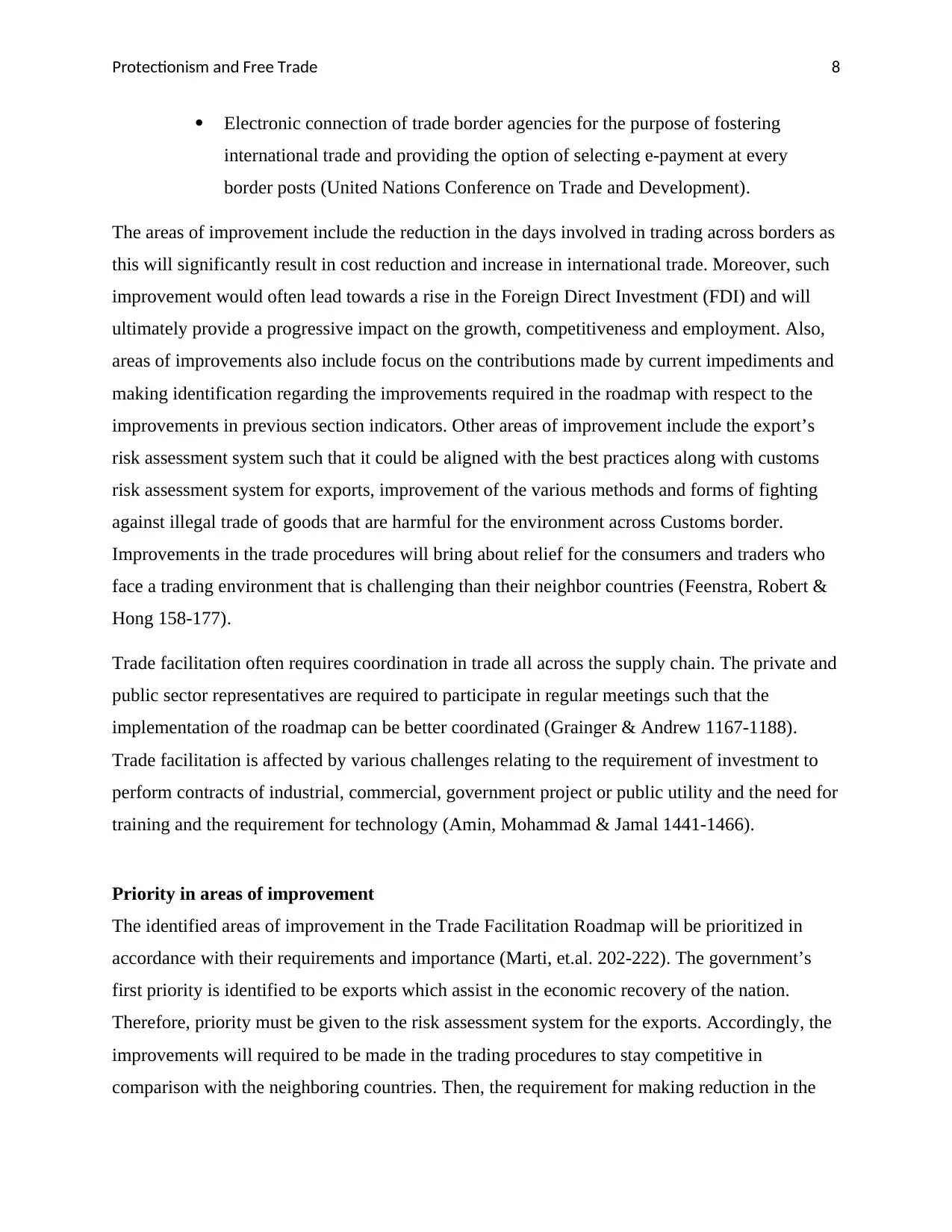
Protectionism and Free Trade 8
Electronic connection of trade border agencies for the purpose of fostering
international trade and providing the option of selecting e-payment at every
border posts (United Nations Conference on Trade and Development).
The areas of improvement include the reduction in the days involved in trading across borders as
this will significantly result in cost reduction and increase in international trade. Moreover, such
improvement would often lead towards a rise in the Foreign Direct Investment (FDI) and will
ultimately provide a progressive impact on the growth, competitiveness and employment. Also,
areas of improvements also include focus on the contributions made by current impediments and
making identification regarding the improvements required in the roadmap with respect to the
improvements in previous section indicators. Other areas of improvement include the export’s
risk assessment system such that it could be aligned with the best practices along with customs
risk assessment system for exports, improvement of the various methods and forms of fighting
against illegal trade of goods that are harmful for the environment across Customs border.
Improvements in the trade procedures will bring about relief for the consumers and traders who
face a trading environment that is challenging than their neighbor countries (Feenstra, Robert &
Hong 158-177).
Trade facilitation often requires coordination in trade all across the supply chain. The private and
public sector representatives are required to participate in regular meetings such that the
implementation of the roadmap can be better coordinated (Grainger & Andrew 1167-1188).
Trade facilitation is affected by various challenges relating to the requirement of investment to
perform contracts of industrial, commercial, government project or public utility and the need for
training and the requirement for technology (Amin, Mohammad & Jamal 1441-1466).
Priority in areas of improvement
The identified areas of improvement in the Trade Facilitation Roadmap will be prioritized in
accordance with their requirements and importance (Marti, et.al. 202-222). The government’s
first priority is identified to be exports which assist in the economic recovery of the nation.
Therefore, priority must be given to the risk assessment system for the exports. Accordingly, the
improvements will required to be made in the trading procedures to stay competitive in
comparison with the neighboring countries. Then, the requirement for making reduction in the
Electronic connection of trade border agencies for the purpose of fostering
international trade and providing the option of selecting e-payment at every
border posts (United Nations Conference on Trade and Development).
The areas of improvement include the reduction in the days involved in trading across borders as
this will significantly result in cost reduction and increase in international trade. Moreover, such
improvement would often lead towards a rise in the Foreign Direct Investment (FDI) and will
ultimately provide a progressive impact on the growth, competitiveness and employment. Also,
areas of improvements also include focus on the contributions made by current impediments and
making identification regarding the improvements required in the roadmap with respect to the
improvements in previous section indicators. Other areas of improvement include the export’s
risk assessment system such that it could be aligned with the best practices along with customs
risk assessment system for exports, improvement of the various methods and forms of fighting
against illegal trade of goods that are harmful for the environment across Customs border.
Improvements in the trade procedures will bring about relief for the consumers and traders who
face a trading environment that is challenging than their neighbor countries (Feenstra, Robert &
Hong 158-177).
Trade facilitation often requires coordination in trade all across the supply chain. The private and
public sector representatives are required to participate in regular meetings such that the
implementation of the roadmap can be better coordinated (Grainger & Andrew 1167-1188).
Trade facilitation is affected by various challenges relating to the requirement of investment to
perform contracts of industrial, commercial, government project or public utility and the need for
training and the requirement for technology (Amin, Mohammad & Jamal 1441-1466).
Priority in areas of improvement
The identified areas of improvement in the Trade Facilitation Roadmap will be prioritized in
accordance with their requirements and importance (Marti, et.al. 202-222). The government’s
first priority is identified to be exports which assist in the economic recovery of the nation.
Therefore, priority must be given to the risk assessment system for the exports. Accordingly, the
improvements will required to be made in the trading procedures to stay competitive in
comparison with the neighboring countries. Then, the requirement for making reduction in the
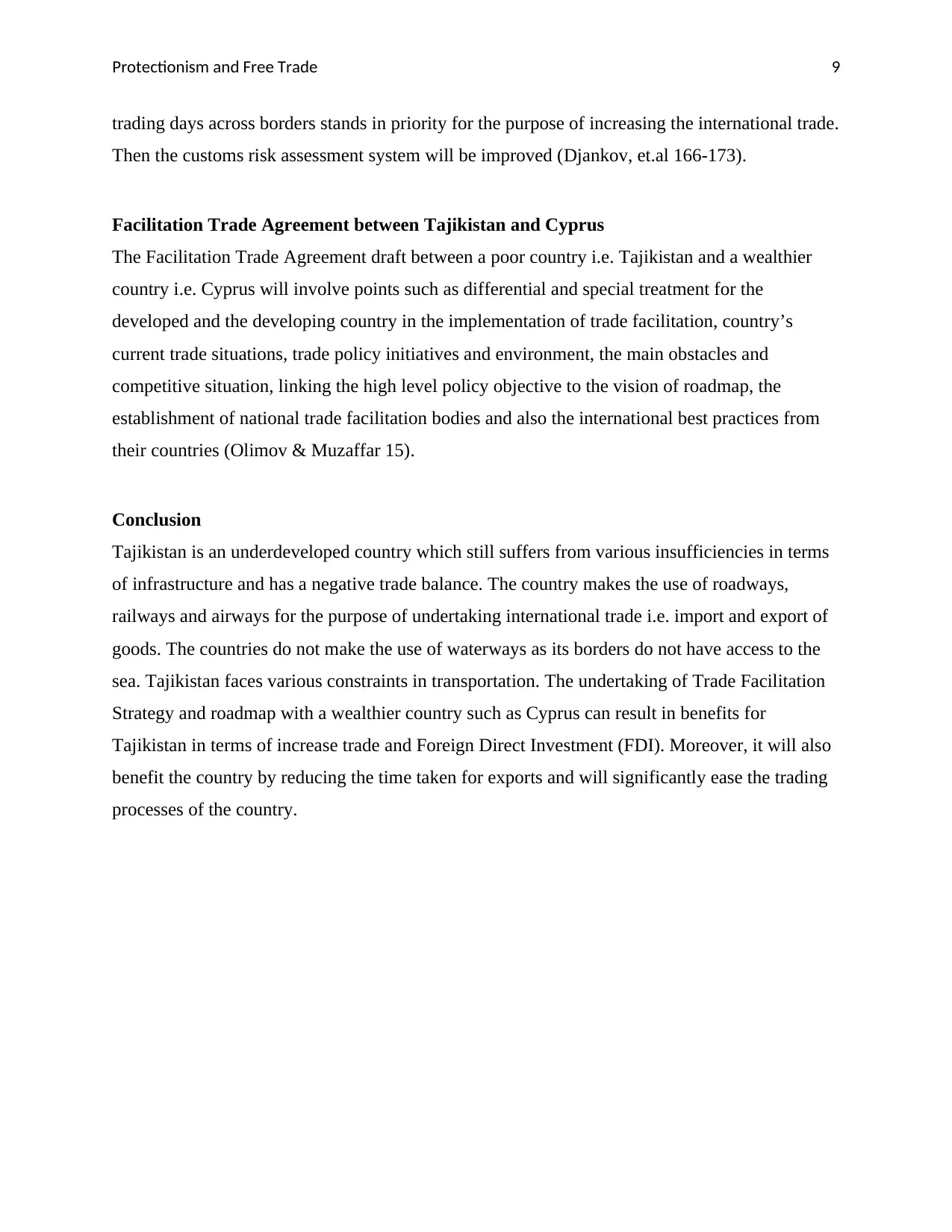
Protectionism and Free Trade 9
trading days across borders stands in priority for the purpose of increasing the international trade.
Then the customs risk assessment system will be improved (Djankov, et.al 166-173).
Facilitation Trade Agreement between Tajikistan and Cyprus
The Facilitation Trade Agreement draft between a poor country i.e. Tajikistan and a wealthier
country i.e. Cyprus will involve points such as differential and special treatment for the
developed and the developing country in the implementation of trade facilitation, country’s
current trade situations, trade policy initiatives and environment, the main obstacles and
competitive situation, linking the high level policy objective to the vision of roadmap, the
establishment of national trade facilitation bodies and also the international best practices from
their countries (Olimov & Muzaffar 15).
Conclusion
Tajikistan is an underdeveloped country which still suffers from various insufficiencies in terms
of infrastructure and has a negative trade balance. The country makes the use of roadways,
railways and airways for the purpose of undertaking international trade i.e. import and export of
goods. The countries do not make the use of waterways as its borders do not have access to the
sea. Tajikistan faces various constraints in transportation. The undertaking of Trade Facilitation
Strategy and roadmap with a wealthier country such as Cyprus can result in benefits for
Tajikistan in terms of increase trade and Foreign Direct Investment (FDI). Moreover, it will also
benefit the country by reducing the time taken for exports and will significantly ease the trading
processes of the country.
trading days across borders stands in priority for the purpose of increasing the international trade.
Then the customs risk assessment system will be improved (Djankov, et.al 166-173).
Facilitation Trade Agreement between Tajikistan and Cyprus
The Facilitation Trade Agreement draft between a poor country i.e. Tajikistan and a wealthier
country i.e. Cyprus will involve points such as differential and special treatment for the
developed and the developing country in the implementation of trade facilitation, country’s
current trade situations, trade policy initiatives and environment, the main obstacles and
competitive situation, linking the high level policy objective to the vision of roadmap, the
establishment of national trade facilitation bodies and also the international best practices from
their countries (Olimov & Muzaffar 15).
Conclusion
Tajikistan is an underdeveloped country which still suffers from various insufficiencies in terms
of infrastructure and has a negative trade balance. The country makes the use of roadways,
railways and airways for the purpose of undertaking international trade i.e. import and export of
goods. The countries do not make the use of waterways as its borders do not have access to the
sea. Tajikistan faces various constraints in transportation. The undertaking of Trade Facilitation
Strategy and roadmap with a wealthier country such as Cyprus can result in benefits for
Tajikistan in terms of increase trade and Foreign Direct Investment (FDI). Moreover, it will also
benefit the country by reducing the time taken for exports and will significantly ease the trading
processes of the country.
Secure Best Marks with AI Grader
Need help grading? Try our AI Grader for instant feedback on your assignments.
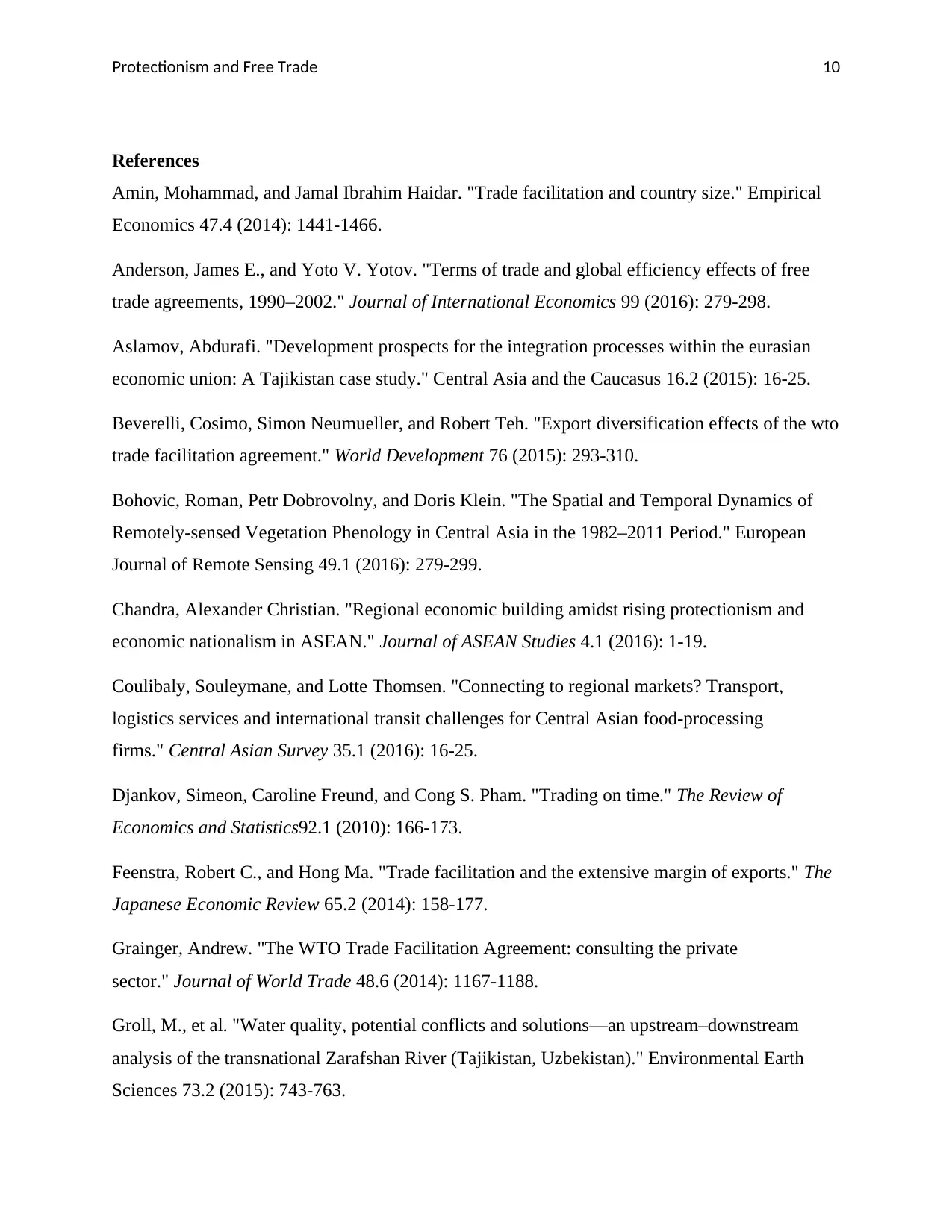
Protectionism and Free Trade 10
References
Amin, Mohammad, and Jamal Ibrahim Haidar. "Trade facilitation and country size." Empirical
Economics 47.4 (2014): 1441-1466.
Anderson, James E., and Yoto V. Yotov. "Terms of trade and global efficiency effects of free
trade agreements, 1990–2002." Journal of International Economics 99 (2016): 279-298.
Aslamov, Abdurafi. "Development prospects for the integration processes within the eurasian
economic union: A Tajikistan case study." Central Asia and the Caucasus 16.2 (2015): 16-25.
Beverelli, Cosimo, Simon Neumueller, and Robert Teh. "Export diversification effects of the wto
trade facilitation agreement." World Development 76 (2015): 293-310.
Bohovic, Roman, Petr Dobrovolny, and Doris Klein. "The Spatial and Temporal Dynamics of
Remotely-sensed Vegetation Phenology in Central Asia in the 1982–2011 Period." European
Journal of Remote Sensing 49.1 (2016): 279-299.
Chandra, Alexander Christian. "Regional economic building amidst rising protectionism and
economic nationalism in ASEAN." Journal of ASEAN Studies 4.1 (2016): 1-19.
Coulibaly, Souleymane, and Lotte Thomsen. "Connecting to regional markets? Transport,
logistics services and international transit challenges for Central Asian food-processing
firms." Central Asian Survey 35.1 (2016): 16-25.
Djankov, Simeon, Caroline Freund, and Cong S. Pham. "Trading on time." The Review of
Economics and Statistics92.1 (2010): 166-173.
Feenstra, Robert C., and Hong Ma. "Trade facilitation and the extensive margin of exports." The
Japanese Economic Review 65.2 (2014): 158-177.
Grainger, Andrew. "The WTO Trade Facilitation Agreement: consulting the private
sector." Journal of World Trade 48.6 (2014): 1167-1188.
Groll, M., et al. "Water quality, potential conflicts and solutions—an upstream–downstream
analysis of the transnational Zarafshan River (Tajikistan, Uzbekistan)." Environmental Earth
Sciences 73.2 (2015): 743-763.
References
Amin, Mohammad, and Jamal Ibrahim Haidar. "Trade facilitation and country size." Empirical
Economics 47.4 (2014): 1441-1466.
Anderson, James E., and Yoto V. Yotov. "Terms of trade and global efficiency effects of free
trade agreements, 1990–2002." Journal of International Economics 99 (2016): 279-298.
Aslamov, Abdurafi. "Development prospects for the integration processes within the eurasian
economic union: A Tajikistan case study." Central Asia and the Caucasus 16.2 (2015): 16-25.
Beverelli, Cosimo, Simon Neumueller, and Robert Teh. "Export diversification effects of the wto
trade facilitation agreement." World Development 76 (2015): 293-310.
Bohovic, Roman, Petr Dobrovolny, and Doris Klein. "The Spatial and Temporal Dynamics of
Remotely-sensed Vegetation Phenology in Central Asia in the 1982–2011 Period." European
Journal of Remote Sensing 49.1 (2016): 279-299.
Chandra, Alexander Christian. "Regional economic building amidst rising protectionism and
economic nationalism in ASEAN." Journal of ASEAN Studies 4.1 (2016): 1-19.
Coulibaly, Souleymane, and Lotte Thomsen. "Connecting to regional markets? Transport,
logistics services and international transit challenges for Central Asian food-processing
firms." Central Asian Survey 35.1 (2016): 16-25.
Djankov, Simeon, Caroline Freund, and Cong S. Pham. "Trading on time." The Review of
Economics and Statistics92.1 (2010): 166-173.
Feenstra, Robert C., and Hong Ma. "Trade facilitation and the extensive margin of exports." The
Japanese Economic Review 65.2 (2014): 158-177.
Grainger, Andrew. "The WTO Trade Facilitation Agreement: consulting the private
sector." Journal of World Trade 48.6 (2014): 1167-1188.
Groll, M., et al. "Water quality, potential conflicts and solutions—an upstream–downstream
analysis of the transnational Zarafshan River (Tajikistan, Uzbekistan)." Environmental Earth
Sciences 73.2 (2015): 743-763.
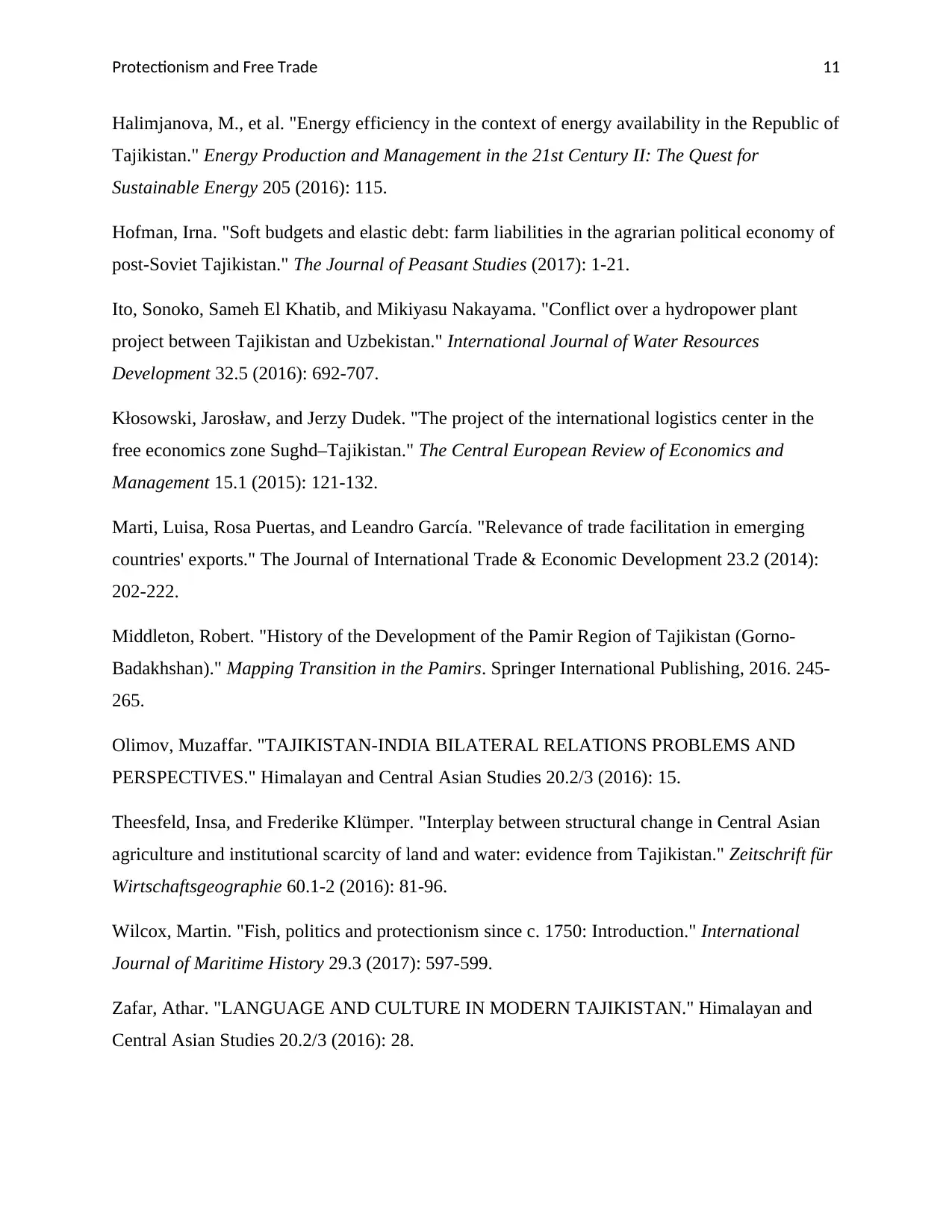
Protectionism and Free Trade 11
Halimjanova, M., et al. "Energy efficiency in the context of energy availability in the Republic of
Tajikistan." Energy Production and Management in the 21st Century II: The Quest for
Sustainable Energy 205 (2016): 115.
Hofman, Irna. "Soft budgets and elastic debt: farm liabilities in the agrarian political economy of
post-Soviet Tajikistan." The Journal of Peasant Studies (2017): 1-21.
Ito, Sonoko, Sameh El Khatib, and Mikiyasu Nakayama. "Conflict over a hydropower plant
project between Tajikistan and Uzbekistan." International Journal of Water Resources
Development 32.5 (2016): 692-707.
Kłosowski, Jarosław, and Jerzy Dudek. "The project of the international logistics center in the
free economics zone Sughd–Tajikistan." The Central European Review of Economics and
Management 15.1 (2015): 121-132.
Marti, Luisa, Rosa Puertas, and Leandro García. "Relevance of trade facilitation in emerging
countries' exports." The Journal of International Trade & Economic Development 23.2 (2014):
202-222.
Middleton, Robert. "History of the Development of the Pamir Region of Tajikistan (Gorno-
Badakhshan)." Mapping Transition in the Pamirs. Springer International Publishing, 2016. 245-
265.
Olimov, Muzaffar. "TAJIKISTAN-INDIA BILATERAL RELATIONS PROBLEMS AND
PERSPECTIVES." Himalayan and Central Asian Studies 20.2/3 (2016): 15.
Theesfeld, Insa, and Frederike Klümper. "Interplay between structural change in Central Asian
agriculture and institutional scarcity of land and water: evidence from Tajikistan." Zeitschrift für
Wirtschaftsgeographie 60.1-2 (2016): 81-96.
Wilcox, Martin. "Fish, politics and protectionism since c. 1750: Introduction." International
Journal of Maritime History 29.3 (2017): 597-599.
Zafar, Athar. "LANGUAGE AND CULTURE IN MODERN TAJIKISTAN." Himalayan and
Central Asian Studies 20.2/3 (2016): 28.
Halimjanova, M., et al. "Energy efficiency in the context of energy availability in the Republic of
Tajikistan." Energy Production and Management in the 21st Century II: The Quest for
Sustainable Energy 205 (2016): 115.
Hofman, Irna. "Soft budgets and elastic debt: farm liabilities in the agrarian political economy of
post-Soviet Tajikistan." The Journal of Peasant Studies (2017): 1-21.
Ito, Sonoko, Sameh El Khatib, and Mikiyasu Nakayama. "Conflict over a hydropower plant
project between Tajikistan and Uzbekistan." International Journal of Water Resources
Development 32.5 (2016): 692-707.
Kłosowski, Jarosław, and Jerzy Dudek. "The project of the international logistics center in the
free economics zone Sughd–Tajikistan." The Central European Review of Economics and
Management 15.1 (2015): 121-132.
Marti, Luisa, Rosa Puertas, and Leandro García. "Relevance of trade facilitation in emerging
countries' exports." The Journal of International Trade & Economic Development 23.2 (2014):
202-222.
Middleton, Robert. "History of the Development of the Pamir Region of Tajikistan (Gorno-
Badakhshan)." Mapping Transition in the Pamirs. Springer International Publishing, 2016. 245-
265.
Olimov, Muzaffar. "TAJIKISTAN-INDIA BILATERAL RELATIONS PROBLEMS AND
PERSPECTIVES." Himalayan and Central Asian Studies 20.2/3 (2016): 15.
Theesfeld, Insa, and Frederike Klümper. "Interplay between structural change in Central Asian
agriculture and institutional scarcity of land and water: evidence from Tajikistan." Zeitschrift für
Wirtschaftsgeographie 60.1-2 (2016): 81-96.
Wilcox, Martin. "Fish, politics and protectionism since c. 1750: Introduction." International
Journal of Maritime History 29.3 (2017): 597-599.
Zafar, Athar. "LANGUAGE AND CULTURE IN MODERN TAJIKISTAN." Himalayan and
Central Asian Studies 20.2/3 (2016): 28.
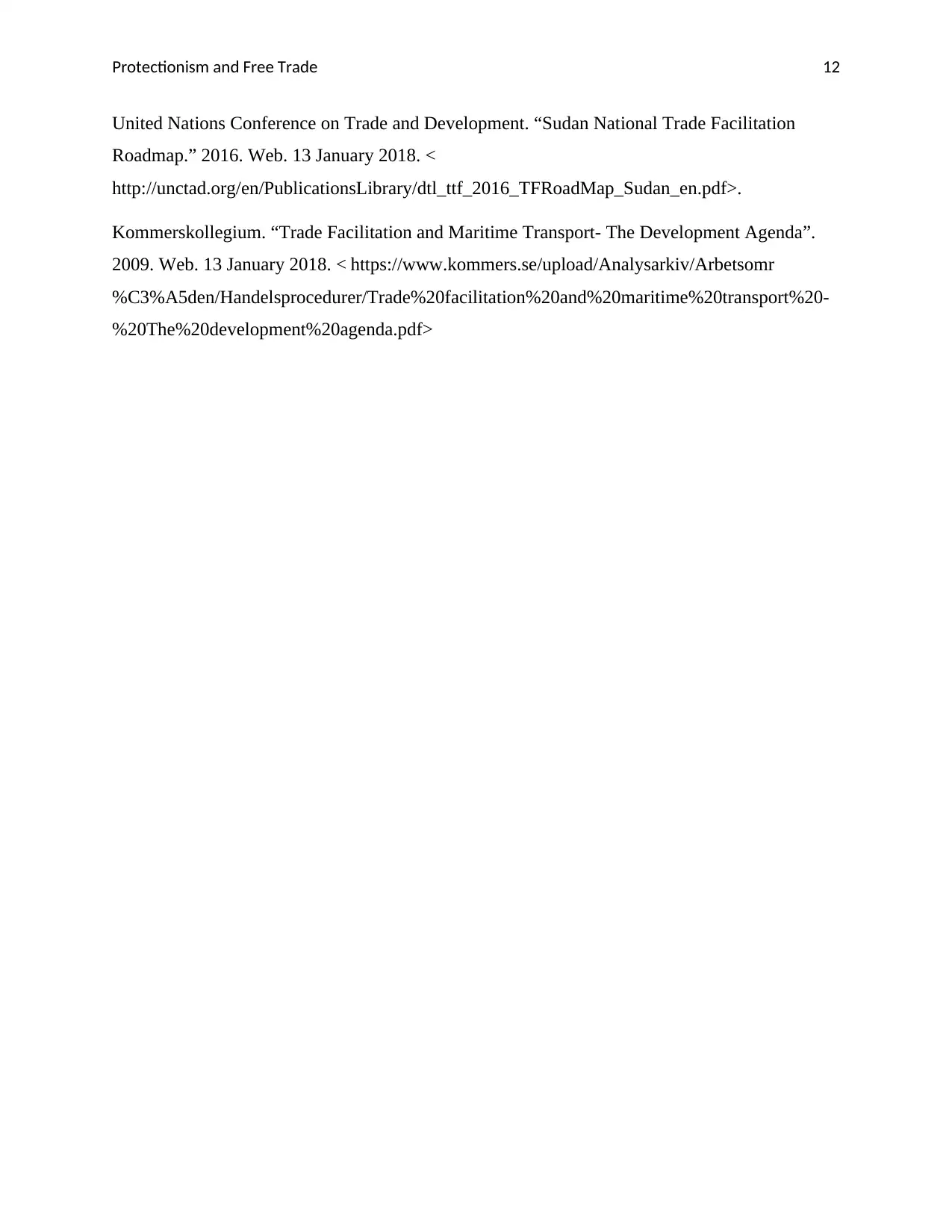
Protectionism and Free Trade 12
United Nations Conference on Trade and Development. “Sudan National Trade Facilitation
Roadmap.” 2016. Web. 13 January 2018. <
http://unctad.org/en/PublicationsLibrary/dtl_ttf_2016_TFRoadMap_Sudan_en.pdf>.
Kommerskollegium. “Trade Facilitation and Maritime Transport- The Development Agenda”.
2009. Web. 13 January 2018. < https://www.kommers.se/upload/Analysarkiv/Arbetsomr
%C3%A5den/Handelsprocedurer/Trade%20facilitation%20and%20maritime%20transport%20-
%20The%20development%20agenda.pdf>
United Nations Conference on Trade and Development. “Sudan National Trade Facilitation
Roadmap.” 2016. Web. 13 January 2018. <
http://unctad.org/en/PublicationsLibrary/dtl_ttf_2016_TFRoadMap_Sudan_en.pdf>.
Kommerskollegium. “Trade Facilitation and Maritime Transport- The Development Agenda”.
2009. Web. 13 January 2018. < https://www.kommers.se/upload/Analysarkiv/Arbetsomr
%C3%A5den/Handelsprocedurer/Trade%20facilitation%20and%20maritime%20transport%20-
%20The%20development%20agenda.pdf>
1 out of 13
Related Documents
Your All-in-One AI-Powered Toolkit for Academic Success.
+13062052269
info@desklib.com
Available 24*7 on WhatsApp / Email
![[object Object]](/_next/static/media/star-bottom.7253800d.svg)
Unlock your academic potential
© 2024 | Zucol Services PVT LTD | All rights reserved.
